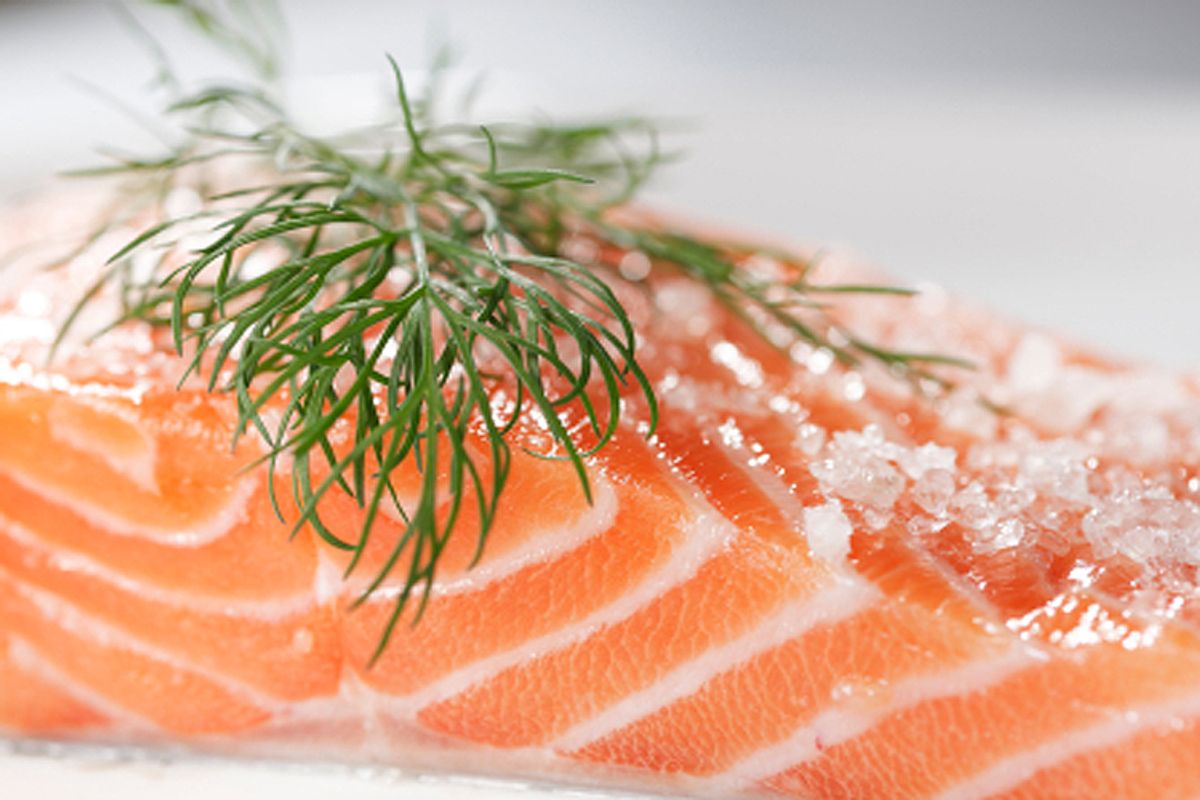Dill and alcohol in a dry salt-and-sugar cure are the defining ingredients for the silky, sweet-and-salty cured salmon called gravlax. Most recipes call for vodka, but I got inspired a few years back when I found that flavors in aquavit match those in the gravlax cure -- specifically dill (Danish Aalborg "Dild"), caraway and coriander. I thought I was some kinda hotshot for making this connection, but while checking out some online recipes I discovered that Mark Bittman (The Minimalist) made his first batch that way many years ago. (He still had half a bottle leftover in his liquor cabinet; that would never happen around here.) In fact, the Scandinavian connection between gravlax and caraway-flavored vodka is probably not coincidental; the tradition of "drinking snaps" -- having a mutual shot of booze (or more) during the course of the meal (preceded by a drinking song or snapsvisa) -- might have led to an "accidental invention."
There is not much to making gravlax. You just make a dry rub, coat the salmon (and massage it in), moisten with the booze (aquavit is not available in all states; vodka will work), seal it up, and wait for a day or two.
I modified this recipe from "Professional Charcuterie" by John Kinsella and David T. Harvey.
Gravlax
Ingredients
- 1 1½ to 3 pound, very fresh, clean-smelling salmon fillet
- 6 ounces coarse kosher salt
- 3 ounces brown sugar
- 1 tablespoon white pepper (or grains of paradise, if you got 'em)
- 1 tablespoon coriander seeds
- 1 tablespoon caraway seeds
- 1 tablespoon juniper berries (¼ ounce = about 1 tablespoon for all)
- Fresh dill, to taste
- 2 ounces (¼ cup) aquavit or vodka
Directions
- Combine the spice seeds and white pepper (if whole) and coarsely grind in a spice mill. Combine with the salt and brown sugar and mix well. This is your rub.
- Place the salmon fillet on a piece of aluminum foil or parchment large enough to wrap it. Work the rub into the flesh, mist with aquavit until it is fairly damp (but not soaked). Flip the fish and repeat on the second side, packing the fillet with rub on all sides. Place a few dill sprigs underneath and on the fillet and wrap it in the foil. Wrap the whole package in a double layer of plastic wrap, and place it in a dish large enough to accommodate it. Weigh down the fish with a plate that will sit on it evenly and refrigerate.
- Cure for 24-48 hours, until the salmon is firm to the touch at the thickest part. If it still feels squishy, as if raw, leave in the cure for another 24 hours. Be careful unwrapping it, as the cure will have turned to liquid.
- When you unwrap this bad boy for good, it's gonna be like Christmas! Discard the dill and clean the fillet up, the best you can, using a moist paper towel. Many recipes call for rinsing it at this point, but I feel that you're also washing away some of the flavor when you do that. It will keep for up to 3 weeks in the fridge, as long as you keep it wrapped nicely in butcher's paper or parchment. That brings us to slicing ...
Slicing is an art. Getting slices 5mm or less ("thin enough to read a newspaper through") requires lots of practice (watch this, for example). No matter what you do, you will never be as good as the pros doing it at Zabar's (neither will I), but you can learn the basic technique here. Having a good slicing knife helps. One recommended by America's Test Kitchen is the Victorinox 12-inch Slicer and costs around $40. This is also the knife you'll want when you decide to invite the whole gang over and cook a steamship round.



Shares